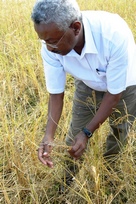Meet 'The Godfather I': Rice plus a dash of salt-and-P with Abdel Ismail
- Thursday, 24 January 2013 14:20

You already met 'The Godfather II' of the 'rocking R' blopost here, and we'd now like for you to meet the original godfather of not only PSTOL1, but also SALTOL. Don't worry: we'll decipher those two cryptic terms in just a moment...
This week, our blogpost profiles Abdelbagi Ismail (pictured), a Plant Physiologist at the International Rice Research Institute (IRRI). Travel with Abdel on an epic journey of discovery that will take you from his native home in Africa on the bountiful banks of the Nile, and on to Asia's ricelands, with a brief stopover America.
Abdel tells us about the passion of his life – plant science – and his active contribution to it. The focus is his work on two rice genes - Saltol, which confers salt tolerance allowing rice to not only grow thrive in saline soils, and its 'phosphoric' counterpart PSTOL1 (phosphorus starvation tolerance) gene, which does the same for rice in phosphorus-poor soils, by improving the uptake of this valuable nutrient. For this reason, project scientists dubbed the location of the PSTOL1 gene as Pup1, standing for phosphorus (P) uptake.
Soil salinity is a major problem, particularly in Asia's coastal regions, where rice-based farming systems are the norm. Moving further out into the rest of world and going further up into the highlands, globally, more than half of all cropland is low in plant-available phosphorus. This poses a serious problem for poor, remote, rice-farming communities that must manage without fertilisers. Many such communities depend on upland rice. And while upland soils may have phosphorus, the problem is that this critical nutrient is locked in forms that are not readily available to rice plants, especially in acid soils.
But let Abdel tell us the story since he does it so much better than we ever could. Please read on!
